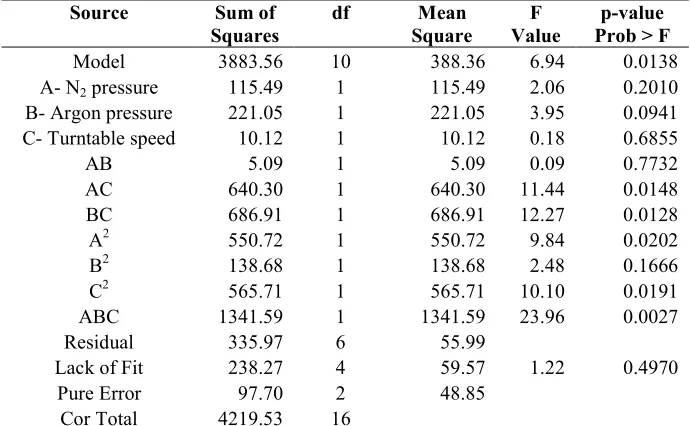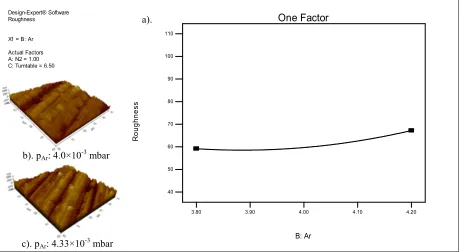Predictive Modeling of TiN Coating Roughness
Abdul Syukor Mohamad Jaya
1,2,a, Siti Zaiton Mohd Hashim
2,b,
Habibollah Haron
2,c,
Muhd. Razali Muhamad
3,d, Md. Nizam Abd. Rahman
3,e,
Abd. Samad Hasan Basari
1,f 1Centre of Advanced Computing Tech., Universiti Teknikal Malaysia Melaka, Hang Tuah Jaya, 76100 Durian Tunggal, Melaka, Malaysia
2
Soft Computing Research Group, Faculty of Computer Science and Information System, Universiti Teknologi Malaysia, 81300 UTM, Skudai, Johor, Malaysia
3
Faculty of Manufacturing Eng., Universiti Teknikal Malaysia Melaka, Hang Tuah Jaya, 76100 Durian Tunggal, Melaka, Malaysia
a
[email protected], [email protected], [email protected], [email protected],
e
[email protected], [email protected]
Keywords: TiN, surface roughness, modeling, sputtering, PVD, RSM, interaction
Abstract. In this paper, an approach in modeling surface roughness of Titanium Nitrite (TiN) coating using Response Surface Method (RSM) is implemented. The TiN coatings were formed using
Physical Vapor Deposition (PVD) sputtering process. N2 pressure, Argon pressure and turntable
speed were selected as process variables. Coating surface roughness as an important coating characteristic was characterized using Atomic Force Microscopy (AFM) equipment. Analysis of variance (ANOVA) is used to determine the significant factors influencing resultant TiN coating roughness. Based on that, a quadratic polynomial model equation represented the process variables and coating roughness was developed. The result indicated that the actual coating roughness of validation runs data fell within the 90% prediction interval (PI) and the residual errors were very low.
The findings from this study suggested that Argon pressure, quadratic term of N2 pressure, quadratic
term of turntable speed, interaction between N2 pressure and turntable speed, and interaction between
Argon pressure and turntable speed influenced the TiN coating surface roughness.
Introduction
In high speed machining, temperature on the cutting tip could exceed 800oC. This condition are
causing tool wear and reducing cutting tool performance. Thus, the cutting tool with high resistance wear is very important to deal with this crucial condition. The machining performance could be improved by applying thin film coating on the cutting tool. The main purpose of the thin film is to enhance the surface properties while maintaining its bulks properties. The coated tool has been proved forty times better in tool wear resistance compared to the uncoated tool [1]. Hard coatings such as Titanium Nitride (TiN) coating are usually used in metal cutting industry due to its coatings performances such as hardness and resistance to wear.
Two main techniques in depositing coating on cutting tool are physical vapor deposition (PVD) and chemical vapor deposition (CVD). The main different between the both processes is the vapour source. In the PVD coating process, the sputtered particle from harder material embedded on the cutting tool in presence of reactive gas.
In PVD coating process, many factors are reported have significant influence to coating characteristics including coating roughness [2-4]. Coating roughness is one of important characteristic that influences machining performances. It effects the friction level and material pick-up behaviour of cutting tool upon sliding with workpiece material [5]. Some of the researches
work done shown that N2 pressure, Argon pressure and turntable speed could have significant effect
on the deposited coating roughness and surface morphology [6-8]. However, the study on the interaction effect among PVD sputtering process parameters is still lacking.
Advanced Materials Research Vol. 626 (2013) pp 219-223 © (2013) Trans Tech Publications, Switzerland
doi:10.4028/www.scientific.net/AMR.626.219
Modeling is a adequate way to address the coating process issues such as cost and customization. However, some modeling approach like Taguchi is difficult to detect the interaction effect of nonlinear process [9]. In this study, the application of RSM technique to model the TiN coating roughness has been discussed. The model is used to predict the coating roughness and indicates the effect and interaction of the coating factors to the coating roughness.
Experiment
Material and Method. The experiment was run in unbalanced PVD magnetron sputtering system made by VACTEC Korean model VTC PVD 1000. The coating chamber was fixed with a vertically mounted titanium (Ti) target. The surface of tungsten carbide inserts was cleaned with alcohol bath in an ultrasonic cleaner for 20 minutes. The tungsten carbide inserts were loaded in the rotating substrate holder inside the coating chamber. To produce the electron in the coating chamber for sputtering purpose, an inert gas called Argon was used. The tungsten carbide inserts were coated with the Ti in presence of nitrogen gas. The other setting of the process were 4kW of sputtering power, 200V of substrate bias voltage and 400̊C of substrate temperature. The coating process was run for 2 hours and
30 minutes. In this process, N2 pressure, Argon pressure and turntable speed were selected as
variables.
Experimental design. In this study, the experimental matrix and data analysis were based on RSM centre cubic design, using Design Expert version 8.0 software. It was designed based on 8 factorial points, 6 axial points and 3 central points. In the experimental matrix, the extreme points (operating window) as the +/- Alpha value was designed. Based on the defined extreme point values, the software then dispensed the high and low settings for the factorial points. The purpose is ensure the characterization could be performed by covering the widest range of operating window.
Atomic Force Microscopy. After the coating process, roughness values of the TiN coatings was inspected by using scanning force microscopy (AFM) method. The method determined the morphology of the surface based with less requirement of sample preparation and non-destructive testing. The AFM Park System XE-100 model was used at room temperature in characterizing coating roughness. The non-contact mode detection approach using a commercial cantilever was used
and the scanning area was set to 25x25 microns (625 µm2).
Response Surface Method (RSM). RSM is a collection of mathematical and statistical techniques to model and analyze problems in which responses (output) are influenced by several input variables [10]. The relationship between the input parameters and output responses is defined using regression analysis in form of polynomial equation. In this work, the regression coefficients such as the coefficients of the model variables including the intercept or constant terms were calculated. However the model need to be tested for statistical significance. The analysis of variance approach (ANOVA) was used to test the statistical significance. The tests for significance of the regression model, significance of individual model coefficient, and lack of fit were calculated.
Result and Discussion
The seventeen experimental run and output response data are shown in Table 1. In this study, the analysis of variance (ANOVA) is used to determine the significant factors influencing resultant TiN coating roughness and the present of interactions affecting the roughness performance. As shown in
Table 2, the ANOVA analysis indicates that the Argon pressure, interaction between N2 pressure and
turntable speed, interaction between Argon pressure and turntable speed, N2 pressure quadratic term
and turntable speed quadratic term are the significant influencing factors of the resultant TiN surface roughness. Even the p-value of “ABC” is also below 0.1, the significant of the “ABC” interaction cannot be determined due to alias nature of cubic term for this experiment setup. From the ANOVA analysis, a second-order response surface model for TiN coating roughness is generated as shown in Eq. 1.
Table 1. Experimental run and result of TiN coating roughness.
Run
Factor 1 Factor 2 Factor 3 Response
A:N2 pressure B:Argon pressure C: Turntable speed Roughness
[×10-3 mbar] [×10-3 mbar] [r.p.m] [nm]
Table 2. ANOVA analysis for TiN coating roughness
Source Sum of
coating roughness increases from 59.17 nm to 67.21 nm, in Fig. 1(a).N2 pressure and turntable speed
are set in 1.0×10-3 mbar and 6.5 rpm respectively. The roughness changes is supported by AFM
images as shown in Fig. 1(b) and Fig. 1(c) with Argon pressure are 4.0×10-3 mbar and 4.33×10-3 mbar
respectively. The Fig. 1(c) shows that the TiN coating has irregular surface morphology compared to surface in Fig. 1(b). The surface roughness is smoother in lower Argon pressure.
Figure 1.(a) Graph of TiN coating roughness behavior in response of Argon pressure, and the different of Argon pressure in (b) and (c) produce different surface roughness.
Interaction between N2 pressure and turntable speed. The interaction is indicated in Fig. 2(a) that
at low turntable speed, 5.0 rpm, as the N2 pressure increases from 0.5×10-3 mbar to 1.5×10-3 mbar, the
TiN coating roughness decreases from 86.47 nm to 62.76 nm, respectively. However the trend is reversed for high turntable speed, 8.0 rpm, where the coating roughness performance increases from
64.9 nm to 78.9 nm as N2 pressure increases from 0.9×10-3 mbar to 1.5×10-3 mbar, respectively. This
indicated the strong existence of interaction between the two process parameters.
Interaction between Argon pressure and turntable speed. Fig. 2(b) shows that the TiN coating roughness drastically increases from 56.12 nm to 82.70 nm at high turntable speed, 8.0 rpm, as the
Argon gas pressure increases from 3.8×10-3 mbar to 4.2×10-3 mbar. However for the low turntable
speed, 5.0 rpm, the coating roughness performance decreases from 76.38 nm to 65.89 nm as Argon
gas pressure increases from 3.8×10-3 mbar to 4.2×10-3 mbar.
(a) (b)
Figure 2.(a) Behaviour of TiN coating roughness relative to interaction between N2 pressure and
turntable speed, and (b) interaction between Argon pressure and turntable speed.
Design-Expert® Software Roughness
X1 = B: Ar
Actual Factors A: N2 = 1.00 C: Turntable = 6.50
3.80 3.90 4.00 4.10 4.20
40 50 60 70 80 90 100 110
B: Ar
R
o
u
g
h
n
e
s
s
One Factor
b). pAr: 4.0×10-3 mbar
c). pAr: 4.33×10-3 mbar
a).
Model validation. Three set of data were collected in other experiment to validate the model. As shown in Table 3, the actual coating roughness of validation runs data fall within the 90% prediction interval (PI). The residual errors which is difference between actual and predicted value for each point as shown in Eq. 2, are ranging between 4.08 to 8.62 in absolute value which percentage residual errors were very low. This indicates that the model is accurate to predict the coating roughness.
= −
i i i
e y y (2)
where eiis residual error, yiis actual value and yiis predicted value.
Table 3. Summary of validation run for TiN coating roughness performance
Input parameters Coating Roughness
Argon gas pressure and turntable speed. In this study, the experimental matrix was developed based on RSM technique. The findings of this study have indicated that Argon pressure, interaction between
N2 pressure and turntable speed, interaction between Argon pressure and turntable speed, N2 pressure
quadratic term and turntable speed quadratic term are the significant process parameters that
influence the deposited TiN coating roughness. Increase in Argon pressure from 4.00×10-3 mbar to
4.2×10-3 mbar resulted in increases of surface roughness. The interaction between N2 pressure and
turntable speed have indicated that at lower turntable speed, the surface roughness decrease drastically. The interaction between Argon pressure and turntable speed have indicated that at lower turntable speed level, the surface roughness increase.
Acknowledgements
The authors would like to thank UTeM and UTM for data and financial support.
References
[1] K. Tuffy, G. Byrne, D. Dowling, Journal of Materials Processing Technology 155-156 (2004) 1861-1866.
[2] P. H. Mayrhofer, C. Mitterer, L. Hultman, H. Clemens, Progress in Materials Science 51 (2006) 1032-1114.
[3] J. Musil, J. Vleck, Material Chemistry and Physics 54 (1998) 116-122.
[4] D. L. Smith, Thin Film Deposition: Principle & Practice, McGraw Hill, New York, 1995.
[5] B. Podgornik, S. Hogmark, O. Sandberg, Surface & Coatings Technology 184 (2004).
[6] K. Chakrabarti, J. J. Jeong, S. K. Hwang, Y. C. Yoo, C. M. Lee, Thin Solid Films 406 (2002)
[10] D. C. Montgomery, Design and Analysis of Experiments, John Wiley and Sons, New Jersey, 2005.


